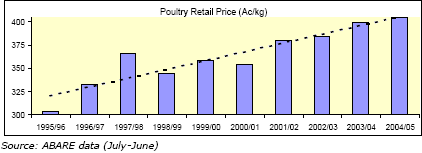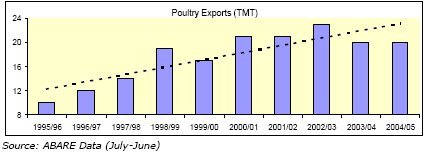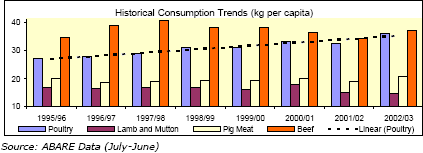



Australia Poultry and Products Annual Overview - September 2005
By the USDA, Foreign Agricultural Service - This article provides the poultry industry data from the USDA FAS Poultry and Products Annual 2005 report for Australia. A link to the full report is also provided. The full report includes all the tabular data which we have ommited from this article.Report Highlights:
Total poultry meat production is forecast to reach a record 830 TMT in 2005/06, up 5 percent on the revised estimate of 792 TMT for 2004/05. Greatly improved feed grain availability, combined with strong consumer demand, is driving the expected production increase.
General
Australian poultry meat production remains dominated by a handful of large, vertically
integrated players. Despite being Australia’s second largest meat industry (by volume), the
poultry meat industry remains domestically focused. Exports account for only about three
percent of domestic production and quarantine regulations largely prohibit the importation of
fresh chicken meat.
The two main drivers for poultry meat production in Australia are consumer demand and the
availability of feed grain. Persistent drought conditions over the past four years significantly
reduced domestic feed grain production while stringent quarantine conditions constrained
access to imported feed grain.
A recent return to normal weather conditions is likely to improve supplies of feed grain over
the short to medium term. Furthermore, the continued trend towards higher white meat
consumption is also likely to see demand for poultry meat improve and is expected to see
retail prices received for poultry meat remain strong.

Production
Total poultry meat production for 2005/06 is forecast at 830,000 MT, up nearly five percent
from the previous year’s revised level. Improved grain supplies combined with continued
strong domestic demand are expected to push production to record levels.
Production for 2004/05 has been revised upwards significantly to 792,000 MT, eight percent
above the previous year and in line with revised Australian Bureau of Agricultural and
Resource Economics (ABARE) estimates. Improved feed grain supply, particularly summer
crop production, allowed total poultry meat production to exceed earlier expectations.
Total poultry meat production in 2002/03 has also been revised upwards to 732,000 MT, in
line with the most recent Australian Bureau of Statistics (ABS) data.

Total broiler meat production in 2005/06 is forecast at 739,000 MT, up nearly five percent
from the revised estimate for the previous year. Official figures are unavailable for broiler
meat production. Post estimates that broiler meat production accounts for around 89
percent of total poultry meat production. Post uses a conversion factor of 0.89 to derive
broiler meat from total poultry meat production.
Broiler meat production for 2004/05 has been revised upwards to 705,000 MT. Earlier
expectations of a partial liquidation in the layer hen flock (Report # AS4025) did not occur
and Post has reverted to using the conversion factor of 0.89 for 2004/05.
Exports
Total poultry meat exports for 2005/06 are forecast at 21,000 MT. Post has revised exports
for 2004/05 downwards to 20,000 MT, in line with ABARE data.
Australia exports only small amo unts of poultry meat, with the industry largely remaining
domestically focused. In 2004/05, South Africa was Australia’s largest export market, taking
around 28 percent of total poultry meat exports. Hong Kong is the second largest export
market, with 23 percent of total exports. According to official ABS statistics, 19 of Australia’s
poultry export markets were islands located in oceans adjacent to the Australian mainland.

Imports
Australian quarantine regulations prohibit the importation of fresh chicken meat, primarily
given concerns about infectious bursal disease (IBD). Importation of cooked chicken meat is
permitted under very strict conditions. As a result of these quarantine conditions, poultry
imports are virtually zero.
Australia has been working on a generic Import Risk Analysis (IRA) for uncooked chicken
meat since 1997. Post continues to anticipate the release of the draft IRA in the not-toodistant
future. The United States, Thailand and the European Union would be among the
potential suppliers of fresh poultry to Australia.
Domestic Consumption
Domestic poultry meat consumption for 2005/06 is forecast at 809,000 MT, up five percent
from the revised estimate for the previous year and in line with the forecast increase in
production. Poultry meat consumption has benefited greatly over the past decade from the
general trend toward white meat consumption.
Official up-to-date ABS consumption figures are unavailable. Post figures are derived from
production and export data. Historical ABARE figures indicate poultry consumption has
increased steadily over the past decade.

Further Information
To read the full report please click here (PDF)
Source: USDA Foreign Agricultural Service - September 2005








